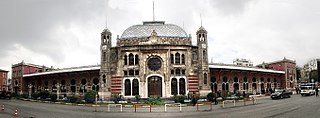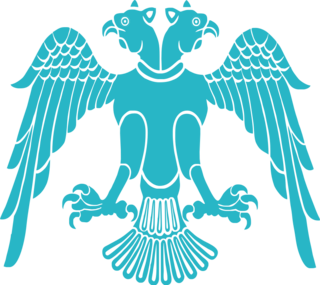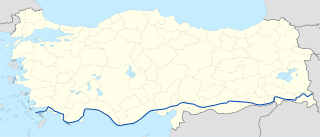
Turkey is primarily a country of two peninsulas: the Asiatic (southeastern) side is Anatolia, and the European (northwestern) side is Thrace on the Balkan Peninsula. On these two main peninsulas there are secondary peninsulas. [1] [2] [3]

Turkey is primarily a country of two peninsulas: the Asiatic (southeastern) side is Anatolia, and the European (northwestern) side is Thrace on the Balkan Peninsula. On these two main peninsulas there are secondary peninsulas. [1] [2] [3]
| Peninsula | Main peninsula | Sea | Province |
|---|---|---|---|
| Boztepe | Anatolia | Black Sea | Sinop |
| Çatalca | Thrace | Between Black Sea and Marmara | İstanbul |
| Kocaeli | Anatolia | Between Black Sea and Marmara | İstanbul and Kocaeli |
| Armutlu | Anatolia | Marmara | Yalova |
| Kapıdağ | Anatolia | Marmara | Balıkesir |
| Gelibolu | Thrace | Between Marmara and Aegean Sea | Çanakkale |
| Biga (Troad) | Anatolia | Between Marmara and Aegean Sea | Çanakkale |
| Karaburun | Anatolia | Aegean Sea | İzmir |
| Güvercin | Anatolia | Aegean Sea | Aydın |
| Dilek | Anatolia | Aegean Sea | Aydın |
| Bodrum | Anatolia | Aegean Sea | Muğla |
| Datça (Reşadiye) | Anatolia | Aegean Sea | Muğla |
| Bozburun | Anatolia | Between Aegean and Mediterranean Seas | Muğla |
| Kapıdağ | Anatolia | Mediterranean Sea | Muğla |
| Çukurbağ | Anatolia | Mediterranean Sea | Antalya |
| Teke | Anatolia | Mediterranean Sea | Muğla, Antalya |

The Sultanate of Rûm was a culturally Turco-Persian Sunni Muslim state, established over conquered Byzantine territories and peoples (Rûm) of Anatolia by the Seljuk Turks following their entry into Anatolia after the Battle of Manzikert (1071). The name Rûm was a synonym for the medieval Eastern Roman Empire and its peoples, as it remains in modern Turkish. The name is derived from the Aramaic (rhπmÈ) and Parthian (frwm) names for ancient Rome, itself ultimately a loan from Greek Ῥωμαῖοι (Romaioi).

The naval battle of Cheshme took place on 5–7 July 1770 during the Russo-Turkish War (1768–1774) near and in Çeşme Bay, in the area between the western tip of Anatolia and the island of Chios, which was the site of a number of past naval battles between the Ottoman Empire and the Republic of Venice. It was a part of the Orlov Revolt of 1770, a precursor to the later Greek War of Independence (1821–1829), and the first of a number of disastrous fleet battles for the Ottomans against Russia. Today it is commemorated as a Day of Military Honour in Russia.

The Republic Monument is a notable monument located at Taksim Square in Istanbul, Turkey, to commemorate the formation of the Turkish Republic in 1923.

Istanbul, formerly known as Constantinople, is the largest city in Turkey, serving as the country's economic, cultural and historic hub. The city straddles the Bosporus strait, lying in both Europe and Asia, and has a population of over 15 million residents, comprising 19% of the population of Turkey. Istanbul is the most populous European city and the world's 15th-largest city.

Levent is a neighbourhood and one of the main business districts of Istanbul, Turkey, located on the European side of the city. It is a part of the municipality of Beşiktaş and is situated to the north of the Golden Horn, at the western shore of the Bosphorus strait.

Sirkeci is a neighborhood in the Eminönü quarter of the Fatih district in Istanbul, Turkey. In the Byzantine period, the area was known as Prosphorion.

The Seljuk dynasty, or Seljukids, also known as Seljuk Turks, Seljuk Turkomans or the Saljuqids, was an Oghuz Turkic, Sunni Muslim dynasty that gradually became Persianate and contributed to the Turco-Persian tradition in the medieval Middle East and Central Asia. The Seljuks established the Seljuk Empire (1037–1194), the Sultanate of Kermân (1041–1186) and the Sultanate of Rum (1074–1308), which at their heights stretched from Iran to Anatolia and were the prime targets of the First Crusade.

Halit Refiğ was a Turkish film director, film producer, screenwriter and writer. He made around sixty films, including feature films, documentaries and TV serials. He is considered to be the pioneer of the National Cinema movement and the initiator of the production of TV serials in Turkey.

Kuzguncuk is a neighborhood in the Üsküdar district on the Asian side of the Bosphorus in Istanbul, Turkey. The neighborhood is centered on a valley opening to the Bosphorus and is somewhat isolated from the main part of the city, being surrounded by nature preserves, cemeteries, and a military installation. It is a quiet neighborhood with streets lined with antique Ottoman wooden houses.
Mehmet Ufuk Uras is a Turkish left-libertarian politician and economist.

D.400 is an east–west state road in southern Turkey. The 2,057-kilometre (1,278 mi) road starts at Datça in the southwest corner of the Anatolian peninsula. The road ends at the Iranian border at Esendere.
This is a male family tree for all the Ottoman sultans and their wives.
Turkey straddles two peninsulas: Anatolia in Asia and Thrace in Europe. The surrounding seas are the Black Sea, Sea of Marmara, Aegean Sea and Mediterranean Sea. But the number of gulfs in the north and the south (Mediterranean) is not high, because the mountain ranges lie more or less parallel to the coastline both in the north and in the south. The majority of bays are on the west, where the mountain ranges are perpendicular to the coastline.
Gulf of Mersin is one of the widest gulfs in Turkey. It is in the northeast of the Mediterranean Sea between the gulfs of İskenderun and Antalya.
Photography in Turkey began in the late nineteenth century.
Kemankeş Kara Mustafa Pasha was an Ottoman Albanian military officer and statesman. He served as Kapudan Pasha and as grand vizier.

The Intercontinental Derby, also known as the Eternal Rivalry, is the name given to any basketball match between Fenerbahçe SK and Galatasaray SK, teams of the Asian and the European parts of Istanbul respectively. Fenerbahçe is the most successful of the two clubs, having won more overall trophies in past seasons and derby games.

The Armutlu Peninsula is a peninsula extending westward into Marmara Sea in the Anatolian section of Turkey. In addition to Yalova Province, parts of Kocaeli Province and Bursa Province are on the peninsula.